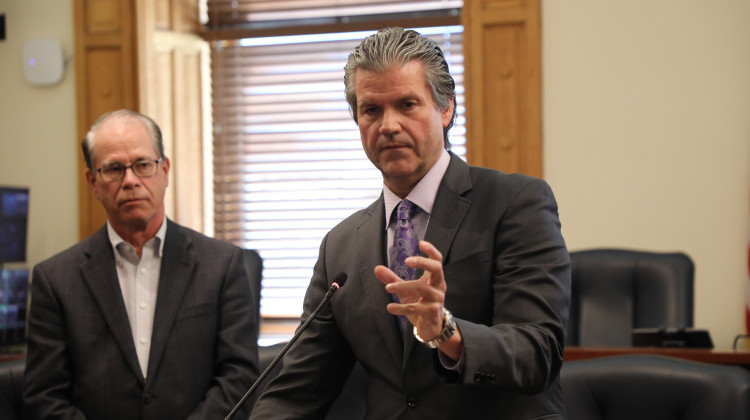 Tom Davis, 62, starts his tour of Crown Hill Cemetery at the Before I Die Wall. Davis suffered a heart attack on March 22. -- Photo: Jake Harper/Side Effects
Tom Davis, 62, starts his tour of Crown Hill Cemetery at the Before I Die Wall. Davis suffered a heart attack on March 22. -- Photo: Jake Harper/Side Effects
In sunny patch of grass in the middle of Indianapolis’s Crown Hill Cemetery, 45 people gathered around a large blackboard. The words “Before I die…” were stenciled on the board in bold white letters.
Sixty-two-year-old Tom Davis, was leading this tour through the thousands of gravestones scattered across across the cemetery. He has thought about his life and death a lot in the last few weeks. On March 22, he had a heart attack.
Davis said he originally planned to write, “I want to believe people care about me.” But after his heart attack: “All these people started caring about me, so be careful what you write on the wall,” he joked. Now Davis, who gave the tour wearing a portable defibrillator, has something new to write: “I want to see my grandkids grow up.”
At the end of the tour, people had the chance to write their dreams in chalk, including some whimsical ones: Hold a sloth. Visit an active volcano. Finally see Star Wars.
The tour was part of the city’s Before I Die Festival, held mid-April, the first of its kind in the U.S. The original Before I Die Festival was held in Cardiff, Wales in 2013, and the idea has since spread to the U.K. and now, Indianapolis.
The purpose is to get people thinking ahead—from what they want to accomplish, to end-of-life care, to funeral arrangements—and to spark conversations.
“This is an opportunity to begin to change the culture, to make it possible for people to think about and talk about death so it’s not a mystery,” says the festival’s organizer Lucia Wocial, a nurse ethicist at the Fairbanks Center for Medical Ethics.
The festival included films, book discussions and death-related art. One exhibit at the Kurt Vonnegut Museum had on display 61 pairs of boots, representing the fallen soldiers from Indiana who died at age 21 or younger.
 People discuss end-of-life planning at a death cafe in the Stutz Art Gallery. -- Photo: Jake Harper/Side Effects
People discuss end-of-life planning at a death cafe in the Stutz Art Gallery. -- Photo: Jake Harper/Side Effects
These festivals grew out of a larger movement that includes Death Cafes, salon-like discussions of death that are held in dozens of cities around the country, and Before I Die walls, which have gone up in more than 1,000 places around the world.
“Death has changed,” says Wocial. “Years ago people just died. Now death in many cases is an orchestrated event.”
She says medicine has brought new ways to extend life, forcing patients and families to make a lot of end-of-life decisions about things people may not have thought of in advance.
“You’re probably not just going to drop dead one day,” she says.
And these decisions can have drastic financial consequences. About a quarter of Medicare spending goes to end-of-life care. What insurance doesn’t cover is left to the patients and families.
“Many families want to do whatever they can for their loved one, and they can end up in bankruptcy,” says Rosemary Gibson, senior advisor at the Hastings Center and author of The Treatment Trap. She says communicating end-of-life healthcare decisions to family can help prevent treatment measures that patients may see as drastic or unnecessary
With that in mind, the festival organizers included a workshop on advance care planning, like writing advance directives. These are documents that tell physicians and hospitals what interventions, if any, to make on a terminally ill patient’s behalf. Or who can make those decisions if you’re incapacitated.
“If you have thought about it when you’re not in the midst of a crisis, the crisis will be better, guaranteed,” says Wocial.
Another event during the festival was a tour of a crematory in downtown Indianapolis. There are a lot of options for what to do with human ashes. You can place them in a biodegradable urn, have them blown into glass—even turn them into a diamond, for a price.
“Really when it comes to cremation, there's always somebody coming up with a million dollar idea,” said Eddie Beagles, vice president of Flanner and Buchanan, a chain of funeral homes in the Indianapolis area. “If you can think of it, they can do it.”
Our group inspected two retorts, which are basically human-sized ovens. One of them contained a pile of white bones.
“They’re very brittle and powder like,” said Beagles. He says a cremation usually takes about three to four hours, with a retort burning at around 2000 degrees Fahrenheit.
But burning up the soft tissue in the body is just the first step. After that, the remaining pieces of bone get separated from any metal from medical implants. And then the scraps get ground up in something a lot like a blender.
Beagles showed us a pile of detritus, casually picking up a hip replacement, a hollow metal ball and dropping it back in the ashes.
 A hip replacement remains after a body has been cremated. -- Photo: Jake Harper/Side Effects
A hip replacement remains after a body has been cremated. -- Photo: Jake Harper/Side Effects
I’m a health reporter, so I know a fair amount about the things that could kill me. Or are already killing me. But seeing this piece of metal that used to be inside a human being tossed back onto the heap gave me pause.
I’m still young, so death has felt pretty abstract until now. But I could still get in an accident that could kill me or put me in a coma, and the festival made me realize that I’m not prepared for that. I’ve got some thinking to do, and maybe an advance directive to write.
Side Effects Public Media is a collaborative reporting project focused on public health. Jake Harper can be reached at 317-614-0482 or jharper@wfyi.org. Follow him @jkhrpr.
 DONATE
DONATE









 Support WFYI. We can't do it without you.
Support WFYI. We can't do it without you.